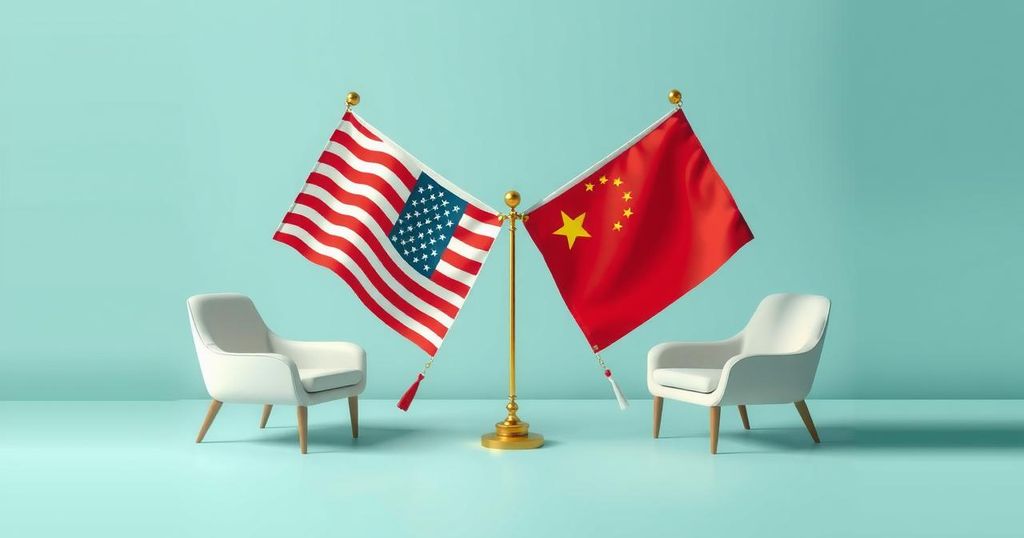Trump Sees Hope in US-China Trade Talks Amid Ongoing Tariff Challenges

President Trump expressed optimism following the first day of US-China trade talks in Geneva, described as a “very good meeting”. With ongoing tariffs in place and uncertain outcomes, both nations face risks if negotiations do not lead to resolution. The event represents a crucial effort to de-escalate the trade war impacting global economies.
In an effort to address ongoing tensions, top US and Chinese officials convened in Geneva, Switzerland this past Saturday for what is seen as a crucial round of trade talks. Both governments have long been locked in a tariff war, which has seriously affected economies in both nations. President Donald Trump was optimistic about the discussions, referring to them as a “very good meeting” that yielded significant dialogue and progress.
The high-stakes negotiations are being led by US Treasury Secretary Scott Bessent and Chinese Vice Premier He Lifeng, marking the first formal in-person talks since the imposition of heavy tariffs on each other’s goods—and they are expected to last through Sunday. Trump took to social media to express his satisfaction with the discussions held, stating there were many agreements discussed and a desire for American businesses to have better access to the Chinese market.
As conversations wrapped up for the day, optimism was present, though there exists uncertainty around the eventual outcomes. Financial markets have been rattled by the trade spats, and product shortages loom on the horizon for American shoppers, which places more pressure on Trump to broker a resolution with China’s Xi Jinping. The Chinese economy shows signs of slowing; it remains to be seen how this will shape the talks.
The official Chinese news agency commented that this meeting represents an important step toward resolving trade friction, emphasizing patience and international cooperation. However, Bessent has been cautious, suggesting discussions are still at an initial stage, focusing more on reducing tensions than reaching a comprehensive deal—contradicting Trump’s more optimistic outlook for substantive agreements.
Commerce Secretary Howard Lutnick asserted that there is “no chance” tariffs would be lifted entirely, regardless of how successful talks might be. Trump has repeatedly stated that tariffs will stay as a critical bargaining chip, maintaining that significant tariffs will remain on Chinese trade until a favorable deal is reached. This is a point emphasized by his administration’s negotiators as they remain steadfast on the current tariff levels.
China’s approach appears guarded, with officials managing expectations ahead of negotiations, viewing them as more open-ended than a guarantee of short-term success. Experts suggest that both parties must be cautious and strategic in their moves, as a miscalculation could worsen the current situation.
Trade volumes between the US and China, about $700 billion annually, have already taken a hit due to tariffs, with predictions suggesting that unresolved issues could lead to 90% of bilateral trade being affected. The ripple effects of this trade dispute are being felt across various supply chains and in consumer markets, as shipping from China to the US has decreased sharply recently.
In addition to the obvious economic ties, the wider implication of the trade fight includes how it affects global trade norms, as the World Trade Organization has revised down its forecasts for commerce, now projecting a slight decline in merchandise trade this year. Analysts have alerted that US consumers could soon experience shortages as the conflict continues.
Despite ongoing turmoil, Trump’s goals remain focused on obtaining concessions from Beijing in terms of market access, making it clear that the Chinese economy has much to gain from these discussions. Nevertheless, Beijing sees the tariffs as part of a broader strategy to curb its rise.
A particularly contentious topic involves US concerns over Chinese export controls on rare earth materials. Tariffs also collide with the pressing issue of fentanyl trafficking, an area the Trump administration is keen to address. Progress on such matters might unfold on tracks separate from the current talks.
As talks progress this weekend, all eyes will be on the outcome, as both nations wrestle with the complex dynamics of trade and diplomacy that could shape economic futures for not just themselves, but also the global market.
Overall, the Geneva trade talks shed light on the precarious relationship between the two economic giants. Just as both presidents hope for favorable negotiations, lingering uncertainties remain about the long-term adjustments needed to foster a more stable economic environment.
The recent US-China trade talks in Geneva mark a significant attempt to unwind the escalating tariff conflicts that have impacted global economies. While optimism from President Trump suggests progress was made, significant hurdles persist, particularly around tariffs and trade practices. Both parties acknowledge the risks of failing to reach a consensus. Ultimately, these negotiations are vital not only for the nations involved but could also influence global market stability. Stakeholders will keenly observe the outcomes as both sides navigate this complex landscape.
Original Source: www.livemint.com








